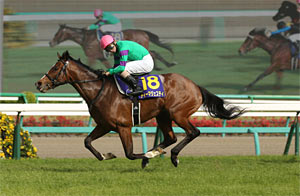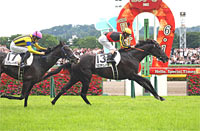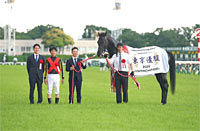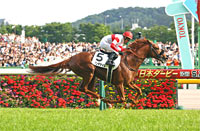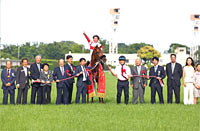2016 News
2016 Tokyo Yushun (Japanese Derby) (G1) - PreviewThe 83rd running of the Tokyo Yushun, or Japanese Derby, is the second leg of Japan’s Triple Crown of racing and will be held on Sunday, May 29. The race is by far the biggest crowd draw of all Japan’s races with easily 100,000 people and upwards making their way to the venue to watch the action. It is the only Japan Racing Association event where the national anthem is played before the race start. Packed stands, rousing fanfare and the pounding of hooves combine for a thrilling, spine-tingling event. The Derby easily tops the Japan Cup and even the Arima Kinen for popularity as eligible 3-year-old colts and fillies get a once-in-a-lifetime chance to make history. Staged at Tokyo Racecourse, the Derby follows the first of the three 3-year-old classics, the 2,000-meter Satsuki Sho (Japanese 2000 Guineas), which was run this year under blustery conditions at Nakayama Racecourse on April 17. The 3,000-meter Kikuka Sho (Japanese St. Leger) in the fall at Kyoto Racecourse wraps up the Triple Crown. Only seven horses have won all Triple Crown races since St. Lite in 1941. The latest winner was Orfevre in 2011. Tokyo Racecourse is a wide-open course with sweeping turns and a long stretch. It is a grueling course and is known for being a true test of strength. The Derby starts in front of the grandstands and completes just over one lap of the course as they execute four turns over an undulating track that is noted for a short upward slope in the backstretch and a long upward run that rises nearly 3 meters from about 900 meters out, with a sharp rise from the top of the stretch until 300 meters before the finish line. Presently, 23 colts have been nominated for this year’s Derby. Eighteen of them will go to the gate on Sunday afternoon and compete over 2,400 meters of turf for a winner’s bounty of 200 million yen. Eighty million goes to the runnerup and 50 million to the third-place finisher. There is motivation aplenty for many. This year’s field is expected to see betting focused on the top finishers of the Satsuki Sho – Dee Majesty, Makahiki and Satono Diamond. The three, in order of their finish in the Triple Crown first leg, will tough it out once again, this time racing to the left as opposed to Nakayama’s righthand track and over an extra 2 furlongs. Will Dee Majesty become the 24th horse in Japan racing history to pocket two jewels of the Triple Crown? Last year’s Satsuki Sho winner Duramente captured the Derby as well and did it rewriting the record books for the first time in a decade with his time of 2 minutes, 23.2 minutes. Dee Majesty won the Satsuki Sho in record time, but may look to the G7 summit for assistance. More accurately, his rider may. Uncannily, two of the past three summits held in Japan coincided with Derby wins that year going to a veteran jockey who had yet to capture the race. In 1993, Masato Shibata, as the Japanese saying goes, “became a man,” by winning the Derby. He made it to the winner’s circle at long last with Winning Ticket on his 19th bid. And, in 2000, Hiroshi Kawachi notched his first Derby – aboard Agnes Flight – on his 17th try. Will the 47-year-old Masayoshi Ebina attain the hallowed ranks aboard Dee Majesty on what will be the rider’s 24th bid? Here’s a look at the expected top picks.Dee Majesty: This son of Triple Crown champion Deep Impact went to the Satsuki Sho gate an unpopular eighth pick but sprang to Derby top billing when he cruised over the line at Nakayama a winner. He has maintained a perfect one-two record – three wins and two seconds in five starts. Breaking from the far outside gate and sitting with cover down the backstretch against a gale-like headwind, Dee Majesty turned into the straight and added tailwind wings to his inborn late speed. He virtually flew home in a Satsuki record time of 1 minute, 57.9 seconds, 0.1 seconds faster than Logotype’s time in 2013. On May 19, Dee Majesty galloped over the woodchip course at Miho Training Center with another horse (“a fast one,” says trainer Yoshitaka Ninomiya) starting a good second ahead of him. Dee Majesty accelerated with more ease than he’s exhibited before and passed the other on the inside. “He looked good, both in his running and the way he changed leads nicely. He’s suited to the Tokyo course and the extra distance is welcome, so I’m looking forward to the race,” Ninomiya said. Ninomiya and jockey Masayoshi Ebina have joined up for the Derby before, albeit unsuccessfully. The combination has, however, been auspicious, including two second-place finishes in the Prix l’Arc de Triomphe, the first with El Condor Pasa in 1999 and the second with Nakayama Festa in 2010. Ninomiya also has yet to bag a Derby. If Ebina can land his first Derby win by bringing Dee Majesty home a winner, he'll become only the third jockey in Japan after Takayoshi Yasuda and Yutaka Take to lay claim to what are known as the Big Eight of Japanese racing – the Oka Sho (Japanese 1000 Guineas), Satsuki Sho, Yushun Himba (Japanese Oaks), Tokyo Yushun, Kikuka Sho, both versions of the Tenno Sho and the Arima Kinen (The Grand Prix). Makahiki: Makahiki, also by Deep Impact, went to the Satsuki Sho gate unbeaten. He and Satono Diamond both tasted defeat for the first time in the fourth start of their young careers. Makahiki, under Yuga Kawada, did everything he could to gain the winner’s circle. He was calm and waited patiently even further back than Dee Majesty. At his cue, he responded smartly and moved up, reaching striking distance as the field turned into the stretch. He changed leads neatly at the bottom of the hill and headed for home on the far outside, but it simply was not to be his day. He was beaten to the line by Dee Majesty by a length and a quarter to finish second. Makahiki’s time over the final 3 furlongs, at 33.9 seconds, was a 0.1 seconds faster than Dee Majesty’s and the fastest of the field of 18. Back to avenge his loss, Makahiki worked on the Ritto Training Center woodchip course on May 18. He easily put ground between himself and his running partner and clocked 11.6 seconds over the final furlong. He is well-toned and looks to have gained muscle since the Satsuki Sho. Though kept at the training center from his last start, he is looking relaxed, and in excellent shape. “His responses were good in the workout and his breathing was good too. He has a good appetite as well,” said trainer Yasuo Tomomichi. “Like for his last start, we’ll just breeze him up the hill this week. He always looks good when asked to move out in a race and I think this is his best distance.” Satono Diamond: Until the Satsuki Sho, Satono Diamond had dazzled. He’d never betrayed a favorite billing and had never won by less than 2 1/2 lengths, and never with more than a kiss of the whip. The Nakayama classic brought the first smudge to his pristine record with a third-place finish, 2 1/2 lengths off the winner. He was a bit highstrung in the parade ring but looked in great shape. He looked fine rounding into the final bend, by rider Christophe Lemaire says he was tiring against the headwind on that typhoon-like day. “He’s a big horse, with long legs so he can’t take small steps easily and is less agile. The interference in the stretch hurt,” said trainer Yasutoshi Ikee. “More importantly, horses on or near the lead were holding their ground for many of the races that day and so I’d given instructions to stay fore of midfield. Things didn’t work out as expected for us.” Ikee says Satono Diamond came out of the race well and recovered quickly. The colt’s muscle tone is said to have improved nicely. Working for the past two weeks with Prophet (another Derby runner) as a partner, Satono Diamond was given a hard workout on the woodchip course at Ritto on May 18 and was pushed hard even after the finish line. “The Tokyo 2,400 meter is a race that’s very hard to predict but this horse has good racing sense so I think he’ll be able to handle it,” Ikee said. Leontes: The King Kamehameha-sired Leontes jumped from his debut win to the winner’s circle of the G1 Asahi Futurity Stakes and was named top 2-year-old of 2015. He missed the Yayoi Sho by a neck after making his move just a tad fast. Stepping into the front around the third turn in the Satsuki Sho to get away from an annoying Mount Robson bearing down to his outside, Leontes was hounded by the unrelenting pace. He was unable to get a breather, which likely caused him to crowd another runner and be demoted from fourth to fifth place. Leontes’ dam in Oaks champion Cesario, whose 2010 foal Ephiphania (by Symboli Kris S) captured the Japan Cup. Both bode well for Leontes’ first run at Tokyo and his first run over 2,400 meters. Smart Odin: The Danon Chantilly-sired Smart Odin did not take the usual route to the Derby, a route which usually includes the 2-year-old G1 Asahi Futurity Stakes and the Satsuki Sho. Currently 4-for-6 with one second, he is instead coming off a win of the Kyoto Shimbun Hai, a Grade 2 over 2,200 meters. Before that, he aced the Grade 3 Mainichi Hai at Hanshin over 1,800 meters. He had two starts prior to that at Tokyo, both Grade 3s, both over 1,800 meters. The first was a winning run in the Tokyo Sports Hai Nisai Stakes, followed by a sixth-place finish in the Kyodo News Service Hai, a disappointing performance that could be written off to it having been his first race in nearly three months. Smart Odin has proven he can handle the venue and his ability to run from any position makes him a viable candidate for Derby success. Other horses certainly worth consideration are Satsuki Sho fourth-place runner Air Spinel, as well as two colts who also took an alternative route to the Derby gate, Aoba Sho winner Vanquish Run, by Deep Impact, and the Zenno Rob Roy-sired Red Eldest, runnerup in the Aoba Sho, a Grade 2 over 2,400 meters at Tokyo. Five favorites have won the race over the past 10 runnings. Two others have figured in the money. Double-digit longshots have not won in the past decade, but they have come second or third four times and are not to be overlooked when playing the exotic wagers. The Derby is the 10th race at Tokyo Racecourse on Sunday, May 29, with a post time of 15:40 local time.
|

|















